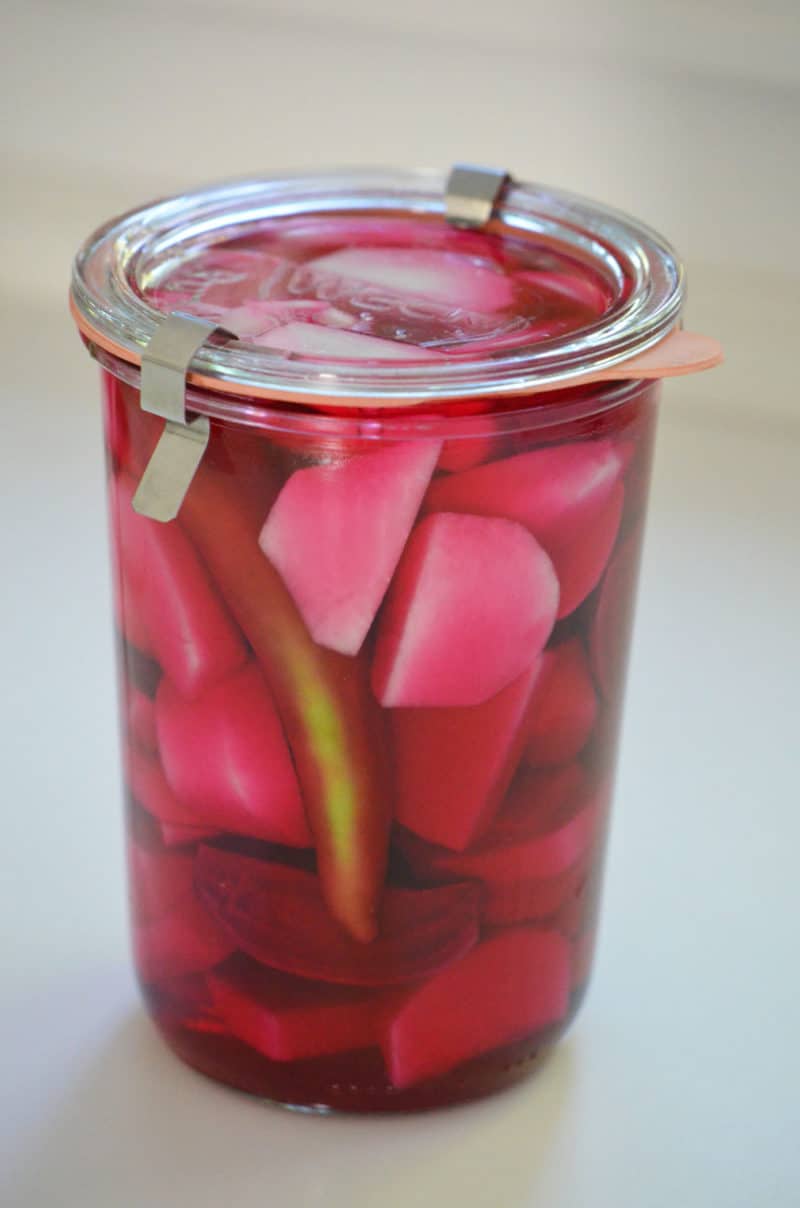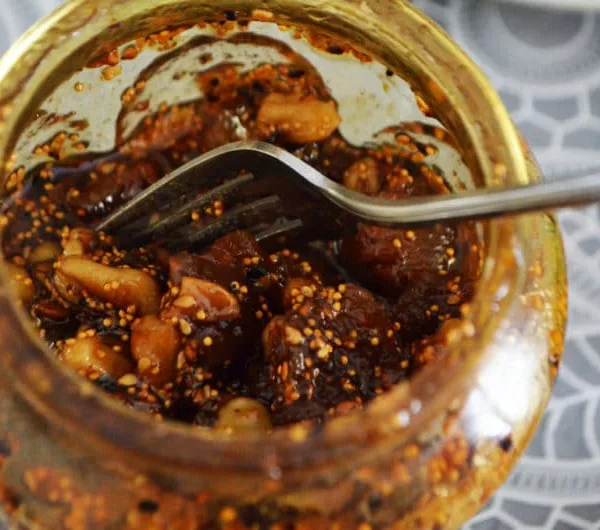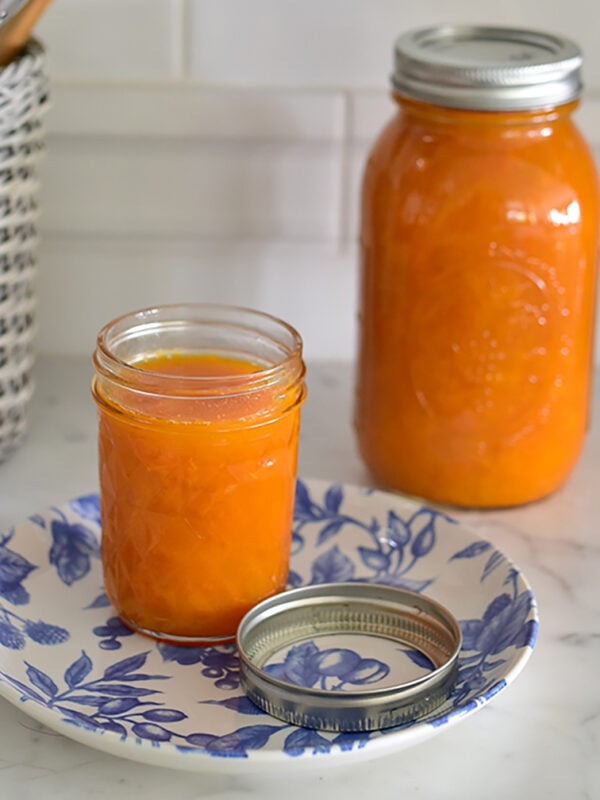This post may contain affiliate links. Please read our disclosure policy.
Fruit leather is a chewy, fruity snack that is so much better homemade! It’s fun to make and takes just a few ingredients and a little (inactive!) time. Bonus: it’s traditional Lebanese!

If it still to this day surprises me, it’s got to be surprising to you too: Fruit leather is so Lebanese. I was eating “fruit leather” long before I’d ever heard that term, and even before we were buying fruit roll-ups at Schmidt’s on Lansing’s west side way back when.
The original Lebanese version of fruit leather is a thicker, sticky apricot paste folded like a letter and wrapped in orange cellophane. It’s called quamerdeen (um-er-DEEN; also qamardeen and qamar el edeen), it tastes so bright, like super-concentrated dried apricots. At home we always considered it a total treat of a day when the orange package showed up on the kitchen counter for us to tear into.
It may be surprising that fruit leather is Lebanese, but not so surprising that the original is apricot. Always apricot and never, ever anything other than apricot, which is the most beloved fruit of the fruit-loving Lebanese.
Homemade qamardeen, or homemade fruit roll-ups, is a great way to transform fresh, seasonal fruit into something extra special. Plus, making your own fruit leather not only allows you to control added sugars but also lets you explore different flavors and enjoy bright fruit flavor with real fruit.

Key Ingredients and Tools for Success
The first step in creating fruit leather is selecting the right ingredients and tools. Fresh fruits are your primary ingredient, and the type of fruit you choose can dramatically influence the flavor and texture. Juicy fruits like fresh strawberries, sweet mangos, or overripe stone fruit work perfectly.
- Fresh Fruit. The world of fruit is your oyster when it comes to fruit leather. I choose apricots! Overripe fruit is a fit here, as these often have a heightened sweetness, reducing the amount of sugar you use.
- Fruit Purée: Start by preparing your fruit purée. I like to cook the fruit to concentrate the flavors and reduce some of the liquid before dehydrating to make the fruit leather. A food processor or blender smooths the fruit mixture into a puree. Aim for about 2-4 cups of fruit purée, depending on how much fruit leather you want to make.
- Sweetener and Flavoring: While some fruits are sweet enough on their own, most need sugar; the sugar also plays a role in the finished texture of the dry fruit leathers (chewy, tacky). I use cane sugar or granulated white sugar. You can use a mix of maple syrup or honey. I always, always enhance the flavor with lemon juice (or lime juice) for a tangy kick that get us to ultra-fruity flavor. Other flavorings add more dimension as well, like a touch of flower waters, vanilla extract or almond extract for depth.
- Tools: Newer, flat (not wrecked!! they sure can get that way fast…) rimmed sheet pans (or cookie sheet – baking sheet) will keep the fruit leather even and flat. A silicone mat is ideal; the fruit leather peels off to a sheen and very easily with the mat. Parchment paper or wax paper are also workable. An offset spatula helps spread the fruit pureé evenly. Choose the right drying method for your convenience and needs. A home kitchen oven set to low heat (the lowest temperature, typically around 140°F) works well. A food dehydrator with dehydrator trays is wonderful for even drying and energy efficiency.







Pro Tips
- Spread Evenly: When spreading the fruit mixture, try to get it as even as possible for even drying. An uneven layer can lead to inconsistent textures, with the outside edge drying faster (and getting too hard) than the center of the leather. The thickness of the spread is about 1/4-inch. If you make a thinner leather, the dehydration process will be shorter.
- Drying Environment: Let the leather dry over at least 6-12 hours in a low heat setting. Touch the top of the spread as it dries. When it’s done, it is barely tacky on top. My fruit leather has gone at least 12 hours and sometimes longer if I make it thicker, which we like a lot!
- Storage: Once dried, the cooled fruit leather rolls up nicely, but it must be set against a layer of wax paper so that it doesn’t stick to itself. Store fruit leather rolled with wax paper or folded with wax paper in an airtight container for weeks (and months!!) at room temperature. The sugar is a form of preservation and the lack of moisture in the fruit leather gives it longevity as well. We like to tear pieces off the big sheet of fruit leather. You can cut the fruit leather into neat strips using a pizza cutter or cookie cutters, ready for lunch boxes and more!
- Avoid Over-Drying: Monitor the moisture content closely. Over-drying can lead to brittleness rather than the chewy texture that is the hallmark of fruit leather!
Lebanese Tradition of Quamardeen
Quamardeen, the traditional Lebanese apricot leather, dates back centuries. It’s a symbolic fruit product in Middle Eastern cuisine, known for its bold flavor and vibrant color. Bringing this traditional way into your kitchen is very fun and exciting. And it sure honors its rich history.
There were true shrieks of delight back when my nieces and nephews, very young at the time, sampled the apricot-lime leather I developed for my first cookbook, which I tied up with green twine for their fun (and let’s face it, my own too!). They practically SANG to me that it’s the BEST fruit leather they’ve EVER eaten, SO much better than the fakey stuff you buy at the store. They say I should SELL it, and call it “Maureenie’s Fruit Treat,” or “Up North Fruit Paste.”

Fruit Leather Recipe
Equipment
- 1 Silpat silicone baking mat
Ingredients
- 1-2 pounds apricots
- 1 lemon, or lime
- 1/4 cup water
- 1/3 cup cane sugar, or granulated sugar
Instructions
- Line a flat, not warped, sheet pan (18”x13”) with a Silpat or parchment paper. Place a rack in the middle position of the oven, and turn on the oven to the lowest setting, about 140˚F.
- Pit the apricots but pulling them apart in half or slicing with a knife first, and removing the pit.
- In a heavy saucepan, bring the fruit, lemon juice, sugar and water to a boil over medium-high heat. Stir occasionally as the fruit cooks; use your spoon to break down the apricots.
- Reduce heat to medium-low and simmer the fruit mixture until fairly smooth, with some chunks remaining, about 15 minutes.
- Puree the cooked fruit in a blender or food processor until smooth, about 30 seconds. Pour the puree on the lined sheet pan and spread evenly with an offset spatula. Try not to touch the sides of the pan with pureé.
- Bake for 6-12 hours, until the leather is mostly dried but still slightly tacky to touch. The length of time this takes depends on the thickness of your fruit. To roll up the fruit, if using a Silpat, peel the entire sheet of leather off the Silpat and lay it on the same sized sheet of waxed paper before cutting into strips and rolling up. f using parchment, do not remove the leather, and cut into strips then roll up. Eat the leather immediately or store in an airtight container in the refrigerator.
Video
Nutrition
Nutrition information is automatically calculated, so should only be used as an approximation.
Experimenting with Flavors and Styles
One delightful aspect of making your own fruit leather is the ability to experiment with different flavors and styles. From strawberry or raspberry fruit leather to orange fruit leather, the sky is the limit with homemade fruit leather recipes. With a little patience, it’s yours!
More Apricot Recipes
Make a batch of Apricot Jam to capture the flavor of fresh apricots.
An Apricot Jam Tart is a beautiful way to enjoy apricot (or any!) jam.
My Apricot Chicken Recipe is so good, with sweet-tart apricots as an easy sauce for chicken.











Hi Maureen.
I absolutely love this fruit leather–grew up on it! I was born in Lebanon and am Armenian. I grew up with Lebanese and Armenian food. I don’t cook enough of either cuisines and should do that more! I love your blog and will definitely make something soon!
Hey Maureen, we were in Lebanon last year visiting homes to learn traditional and we took a lot of photos at the souk el tayeb, the fruit leathers being one of them. We were searching for the name and came upon your post. What an amazing blog you have!! We love Lebanese food and Leila (my partner) is Lebanese so we cook the second best food in the world (behind Italian, my nationality) all the time!! Thanks to your post we now know the aberdeen name!! We would love to meet you and cook with you one day!! Thanks again.
This is terrific! Thanks so much you two!
Oh my God, imagine how surprised I was, am, to see the Ameerdeen. I remember when I was a very little girl in Alexandria, Egypt, I used to love eating it, I was given this from 3-4 years old. I was born in Alexandria, my dad was stationed in Alexandria for the British Admiralty and we were them for 6-1/2 years and then we had to leave there cause trouble was a brewing and we were called back to Malta. My dad was Maltese. When we went to Malta we were looking for it, but could not find it. Up until now I love it, but buying from Middle eastern stores they charge you an arm and a leg for it. Now that I have the recipe, I will definitely try it. See Apricot are my favourite fruit, or rather one of my favorite fruits. I do like all fruits, I might try it with peaches too, when in season which is the summer.
Wonderful!
Erm… Amardeen is definitely Syrian, as is most “so Lebanese” food… Damascus has long been famous for its apricots and its amardeen…
I’ve made this recipe a number of times now. My family loves it as much as I do. Definitely best with fresh apricots but that can be hard to find in Minnesota during the winter. I’ve made it with jarred apricots and while it’s not as good as using fresh it still tastes pretty good. A little bit of sunshine in the cold. We generally have to make a double batch so there is some hope of having some left for the next day. Yum! Thanks for sharing the recipe.
Thank you Courtney–I’m glad to know that this works with jarred apricots! Will have to try that in these off-seasons!
Wonderful, trying this out as we speak! I found your site while looking for an Apricot “fruit leather” recipe and then I saw you were a fellow Michigander so I subscribed! Can’t wait to check out the rest of your site….thanks for the Apricot ideas!
Welcome Kathy! Sounds like you love apricot as much as I do!! Enjoy the fruit leather!
Do the apricots need to be peeled?
Hi Amy–nope, just leave them on–the skins add wonderful flavor!
Just a maybe silly question. I have been given a “flat” of apricots, some bruised, some still a little green on the end. Can I use these? And do I have to peel before pitting? Some sites say to leave the skin on……
Thank you!
Amy, absolutely you can use those apricots. They’ll be great, and I never peel them.
Hi Maureen,
Really enjoying your recipes and photography, extremely inspiring! I am a self-professed amardin-aholic 😉
Looking forward to trying this recipe, just a quick question- most of the syrian dried apricot paste I buy at the Middle Eastern stores list “Olive Oil” as the last ingredient. Any idea where that plays into the Syrian recipe? Shukran!
Hi Susan, and thank you! What an interesting question. I think this may be to do with coating the exterior of the amardin to keep the wrap from sticking to it too much; I don’t think the oil is needed in the making of the fruit leather.
Yum!
I’m gonna make this in my dehydrator today!
I can’t wait to try this recipe. My dad used to bring Apricot “Paper” home from trips to Florida when we were kids. It was so much better than anything you can find today. Thanks!
Hi, I wonder if I can do this with dried apricots. I live in the uk and the apricots I boughts on several occasions ar very sour and hard- they come from Europe not as good as the ones back in the Middle East. I lov reading your blog!
Hi Zainab, and thank you! I have not tried this with dried fruit but you could, taking more time to soften the dried fruit and probably using more water to create a puree. But you might be surprised how even hard, sour apricots take on fabulous flavor cooked with sugar/agave (and perhaps little or no lime, if very sour). Those are well worth a try!
My goodness–your blackberry buns sure look cozy under that blanket of soft powdered sugar. Sorta like winter in July. I’m clipping this recipe to try when I have some free time. I’ve never baked with lavender before and am very curious how it will be. Sounds and looks heavenly, though. Thanks, Maureen.
My brother’s eyes still light up when I bring home the apricot leather from the Syrian bakery. I can’t wait to try this recipe! Do you think it can be made with dried apricots?
Amerdeen! Oh I completely forgot about apricot leather–my Aunt Louise (born in Lebanon) always made it–we all loved it–oh my gosh, the memories you bring back–thank you!
just this morning, my girls (10 & 7) asked me to buy fruit roll-up for their snacks. i told them we would make it instead so your recipe is ever so timely. off to buy a silpat! appreciate the tips!
Who needs kids to try it when it sounds so good. I’ve tried making fruit leather with a cheap-y food dehydrator in the past; it never worked. Excited to try this method. But…so sad all the apricots are gone here!
Super thank you. Always loved the apricot rolls and have been wondering how they are made. Did not know they could be made at home. What is the shelf life (in the fridge) Maureen?
Thank you so much for sharing the recipe.
Thanks Karine! This will hold for at least a week.
Oh I gotta try this! I’m thinking maybe some cherry (after the apricot, of course)
Isn’t that the truth??? Apricot Fruit Leather and Laban…..both were in our Sito’s kitchen and fridge looooog before they became Americas staple food. If we knew then what we knew now, we’d be rich Maureen.. lol!
Love having the recipe for the leather. I always buy mine….now I will make it. Laban on the other hand, is always in my fridge. Thanks for another exciting new recipe for me to try.
HI Maureen,
Wow, I’m delighted to see this. I spent several years in Beirut as a child and loved amerdeen (or mush-mush as the kids called it) beyond measure. No other fruit leather (so far) has been a patch on it, so I’ll look forward to trying this! I also like the sound of those candies…Thanks so much!